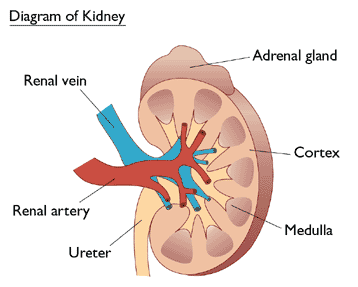Kidneys - definition, strucrure and renal function

What are Kidneys
Kidneys are a pair of organs responsible for filtering wastes and excess water from the BLOOD, excreting both from the body as URINE. The kidneys maintain the body’s fluid and electrolyte balances, and also produce hormones that regulate the production of new erythrocytes (ERYTHROPOIETIN (EPO)) and BLOOD PRESSURE (RENIN). With each heartbeat about 20 percent of the body’s blood supply surges through the kidneys. The body’s entire blood supply passes through the kidneys about two dozen times a day. Though the kidneys are essential for life, a single functioning kidney can adequately sustain life in most people. The kidneys are fully functional from birth.
Renal Structure
The kidneys are dark reddish brown in color, four to five inches long, and about two inches across. An adult kidney weighs five to six ounces, and is the same shape as the bean that bears its name. The kidneys rest against along the spinal column at the back of the abdominal cavity, one on each side of the SPINAL CORD and within the protective enclosure of the rib cage. The kidneys are retroperitoneal—that is, they lie outside the posterior layer of the peritoneum, the membrane that protects the abdominal structures. The left kidney is about an inch higher than the right. A cushion of fatty tissue surrounds each kidney, helping protect it as well as hold it in place. An adrenal gland resides atop each kidney though does not physically or functionally integrate with the kidney.
A thin but tough membrane called the renal capsule surrounds the kidney, helping contain and protect its blood-rich tissues. The outer layer of the kidney is the renal cortex and the inner layer the renal medulla. The renal ARTERY, renal VEIN, and URETER junction with the kidney where it indents, an area called the hilus. Deeper within the kidney at this junction is the renal pelvis, a deltalike region of the kidney that drains urine into the ureter. The functional unit of the kidney is the NEPHRON, a microscopic structure, a set of tubules that carry out the functions filtration, and a coil of capillaries, the GLOMERULUS, which brings in the blood for filtration. Each kidney contains over a million nephrons, each of which functions independently. The nephrons extend through the renal cortex and the renal medulla. The renal cortex contains the blood vessels that bring blood to the nephrons and the glomerulus for each nephron, as well as a portion of filtering tubule. The renal medulla consists of 8 to 12 wedgeshaped segments, called pyramids. The pyramids contain the filtering tubules, including the loop of Henle and the collecting tubule, for each nephron. Blood circulates primarily through the renal cortex, while the structures of the renal medulla direct water and waste products (urine) toward the renal pelvis and elimination via the ureter.
Renal Function
The pressure of the blood as it flows through the glomeruli helps force molecules of water and other substances across the membranous glomerular walls and into an encapsulated structure called Bowman’s capsule. Specialized proteins called transporters carry these substances across the capillary membranes. The collected mixture, called filtrate, funnels from the Bowman’s capsule into the tubules. A separate capillary network, the peritubular capillaries, entwines the filtration tubules to allow water and other substances to return to the blood circulation (reabsorption). By the time a heartbeat’s surge of blood completes its passage through the nephrons, about 99 percent of the water and electrolytes originally filtered from the blood (sodium, potassium, magnesium, calcium, and others) have returned to the circulation.
The kidneys also produce two vital hormones: RENIN, which controls blood pressure, and EPO, which regulates erythropoiesis (the synthesis of new erythrocytes in the BONE MARROW). Health conditions that damage the kidneys also affect their ability to produce these hormones. Interstitial cells (cells in the body of the kidney) produce both hormones.
The pressure of blood flowing through the glomeruli helps determine whether the kidney releases renin, which is a process of perpetual balance. Renin sets in motion the cascade of events through which the body produces angiotensin II, a potent vasoconstrictor (chemical that narrows and stiffens the blood vessels to raise blood pressure). The kidneys also respond to the release of ANTIDIURETIC HORMONE (ADH) from the HYPOTHALAMUS, another mechanism of blood pressure regulation that influences the amount of water the kidneys withhold in the blood or excrete in the urine. The hypothalamus releases ADH to cause the kidneys to withhold more water, which increases the blood volume and thus the blood pressure.
The kidneys also detect the level of erythrocytes that are in the blood as it passes through them, and release erythropoietin when the erythrocyte level drops. Erythropoietin stimulates the production of reticulocytes in the bone marrow and their release into the blood circulation, where they mature to become oxygen-bearing erythrocytes.
| HEALTH CONDITIONS THAT AFFECT THE KIDNEYS | |
|---|---|
| ALPORT’S SYNDROME | END-STAGE RENAL DISEASE (ESRD) |
| GLOMERULONEPHRITIS | GLOMERULOSCLEROSIS |
| GOODPASTURE’S SYNDROME | HEMOLYTIC UREMIC SYNDROME |
| HEPATORENAL FAILURE | HORSESHOE KIDNEY |
| HYDRONEPHROSIS | kidney cyst |
| MINIMAL CHANGE DISEASE | NEPHRITIS |
| NEPHROLITHIASIS | NEPHROPATHY of DIABETES |
| nephropathy of HYPERTENSION | NEPHROTIC SYNDROME |
| POLYCYSTIC KIDNEY DISEASE | pyelonephritis |
| RENAL CANCER | RENAL FAILURE |
| renal osteodystrophy | RENAL TUBULAR ACIDOSIS |
| rhabdomyolysis | WILMS’S TUMOR |
For further discussion of the kidneys within the context of the urinary system’s structure and function please see the overview section “The Urinary System.”
See also BLADDER; ERYTHROCYTE; HEMATOPOIESIS; HORSESHOE KIDNEY; RETICULOCYTE; URETHRA.